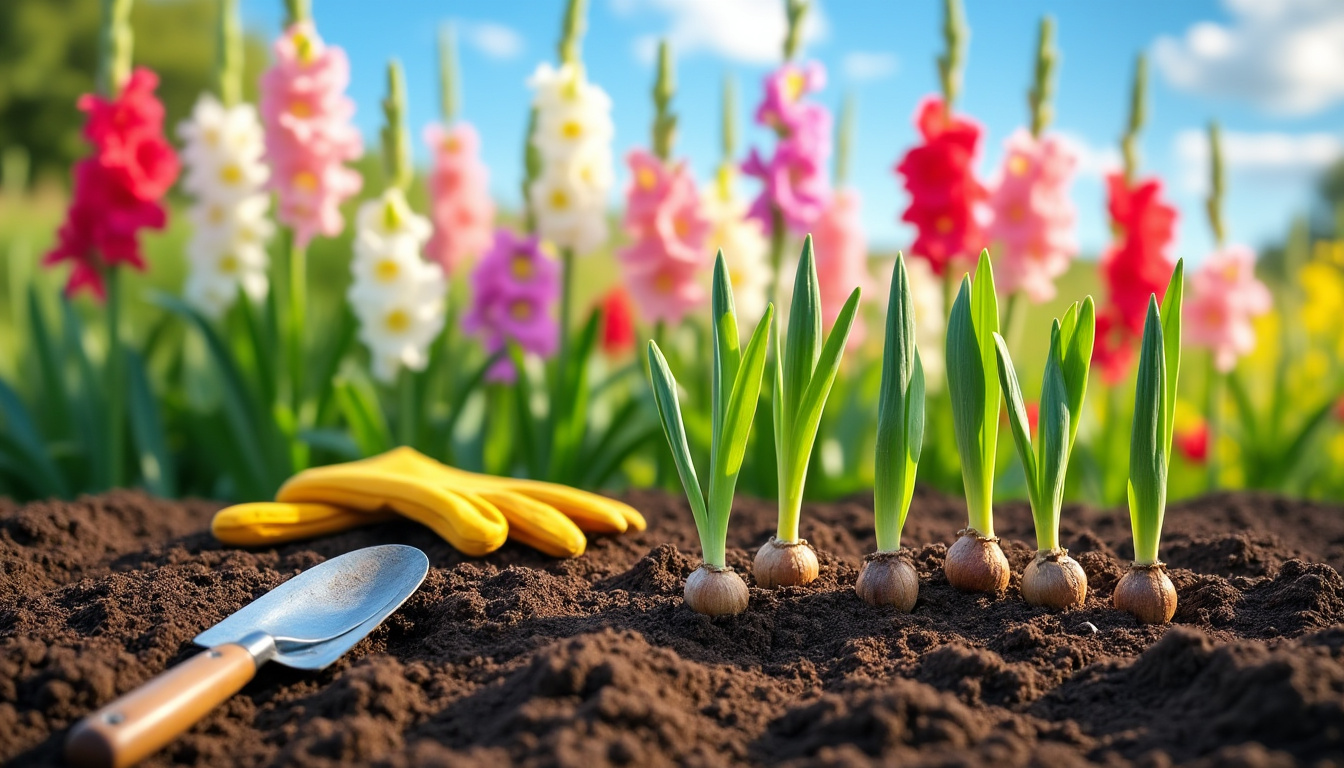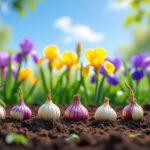Gladioli, with their tall, elegant spikes and vivid hues, can turn any garden into a vibrant spectacle. While their cultivation might seem intimidating, a few simple strategies will ensure your gladiolus flowers bloom beautifully. From selecting the proper planting site to managing moisture and nutrients, these guidelines provide invaluable support for avid gardeners at all skill levels. Prepare to watch as your garden transforms into a stunning display of these majestic blooms!
Choosing the Right Site for Gladioli Planting
Identifying the perfect location in your garden is essential for successful gladiolus growth. These flowers flourish in well-drained soil enriched with organic matter and require full sunlight, ideally receiving at least six hours of exposure daily. It’s crucial to steer clear of waterlogged areas, as excess moisture can lead to bulb rot. If your garden has dense clay soil, mixing in some compost can improve drainage dramatically. By prioritizing the right site, you’ll boost your chances of fostering healthy blooms that effortlessly catch the eye.
Key Elements for Optimal Site Selection
- 🌞 Full sunlight for a minimum of six hours daily.
- 🪴 Well-drained soil, preferably enriched with organic matter.
- 🚫 Avoid areas prone to water pooling to prevent bulb rot.
- 🌱 Improve heavy clay soils with compost for better drainage.
Optimal Planting Time for Gladioli Bulbs
Timing is critical when it comes to planting gladioli bulbs. The best period to sow them is mid-spring, after the last frost has passed, while soil temperatures should ideally exceed 55°F. This ensures that the bulbs anchor themselves before the intense summer heat arrives. If you plant too early, there’s a risk of cold damage, while a late planting may hinder their blooming phase. Strategically timing your planting can lead to a spectacular showcase of colors as the season unfolds.
| Timing | Soil Temperature | Remarks |
|---|---|---|
| Mid-Spring | Above 55°F (13°C) | Ensure frost has passed to protect bulbs. |
| Late Planting | Varies | May delay blooming; not recommended. |
Spacing and Depth for Gladioli Bulbs
The depth and spacing of your gladioli bulbs are vital for ensuring healthy growth. Plant them approximately 4 inches deep, with a distance of 6 inches between each bulb. This allows for adequate air circulation, reducing the chance of disease. For optimal support of the flower weight, deep planting encourages sturdy stem growth. If organizing plants in rows, ensure that they are spaced about 24 inches apart, facilitating easy access for maintenance and care.
Benefits of Proper Bulb Placement
- 🌬️ Enhanced air circulation minimizing disease risk.
- 🌱 Robust stem growth supporting larger blooms.
- 🔄 Ease of maintenance with adequate space between plants.
Watering and Moisture Management for Gladioli
Consistent moisture levels are essential for the robust development of gladiolus plants. During dry spells, regular watering becomes even more important. Aim for a thorough watering session once a week; this encourages the roots to grow deep into the soil. While in the growth phase and during blooming, keep an eye on the soil’s moisture levels. Employing mulch can assist in moisture retention and lessen the frequency of watering dilemmas. Striking the right balance in hydration not only enhances growth but also helps prevent root rot and stunted development.
| Watering Schedule | Soil Moisture Monitoring | Benefits |
|---|---|---|
| Once a week | Observe soil condition during growth | Encourages deep root systems and healthy growth |
| As needed during dry spells | Mulch for moisture retention | Prevents root rot and promotes vigorous blooms |
Fertilizing Gladioli for Optimal Blooming
Proper nutrition greatly impacts the flourishing of your gladiolus flowers. Utilizing a balanced fertilizer with sufficient phosphorus enhances the quantity and quality of the blooms. Apply this fertilizer when your shoots first emerge and repeat every four to six weeks throughout the growing season. Avoid high-nitrogen fertilizers as they promote foliage at the expense of blossoms. If you prefer organic options, consider using compost or well-aged manure to enrich your soil. With consistent feeding, your gladiolus plants will be primed for endless vibrant blooms.
Fertilizer Application Guide
- 🌾 Use a fertilizer high in phosphorus.
- 🕒 Start at shoot emergence, reapply every 4-6 weeks.
- 🌿 Avoid high-nitrogen fertilizers to maintain bloom focus.
Supporting Gladioli for Spectacular Blooms
The tall flower spikes of gladioli often require additional support to withstand wind and heavy blossoms. Using stakes or plants supports as growth progresses, especially in windy zones, is recommended. Bamboo stakes or metal rods provide discreet yet effective assistance. Gently tie stems to these supports with soft material, allowing for some movement with the wind. By taking this precaution, you help your gladiolus retain their upright beauty, particularly when showcasing their full bloom potential.
Pest and Disease Management for Gladioli Plants
Maintaining kaleidoscopic blooms hinges upon diligent pest and disease management. Routine checks for aphids, thrips, and fungal infections on the leaves and stems are vital. On detecting any issues, promptly remove the affected parts and consider organic solutions like neem oil. Ensuring good circulation and avoiding excessive overhead watering can significantly reduce disease incidence. Practicing crop rotation is another effective method for minimizing pest accumulation in the soil. A proactive approach safeguards your gladioli, keeping them healthy and resplendent throughout the season.
| Pest/Disease Type | Signs to Watch For | Management Strategies |
|---|---|---|
| Aphids | Curled leaves, sticky residue | Remove affected parts, use neem oil |
| Thrips | Silvery streaks on leaves | Maintain good airflow, remove debris |
| Fungal Diseases | Browning foliage, wilting | Avoid overhead watering, crop rotation |
Deadheading and Pruning for Enhanced Blooms
To maximize your gladiolus’s flowering potential, regularly remove spent blooms through the process known as deadheading. Using sharp scissors, cut faded flowers just above the nearest leaves. This promotes the plant’s energy to focus on fostering new blooms rather than wasting resources on fading flowers. Additionally, pruning yellowed or damaged leaves can demote the risk of disease spread while ensuring the plants appear tidy. Implementing these practices rewards you with captivating blooms throughout the gardening season.
When is the best time to plant wildflower seeds for optimal growth?
Preparing Gladioli for Winter
As winter approaches, it’s crucial to prepare your gladiolus bulbs against harsh conditions. For areas with freezing winters, carefully dig up the bulbs after the first frost, cleaning off the excess soil, and allow them to dry before storing. Choose a cool, dry environment for storage to prevent freeze damage. In milder regions, a thick layer of mulch may protect the bulbs during cold months. Proper winter preparation ensures that your gladioli bulbs are ready for replanting in spring, fostering a beautiful garden every year.
FAQs About Gladioli Growth and Care
- What is the ideal planting depth for gladioli bulbs? They should be planted about 4 inches deep to ensure proper growth.
- How often should I water gladiolus plants? A deep watering once a week is typically sufficient, especially during dry spells.
- When should I fertilize my gladiolus? Fertilizer should be applied every four to six weeks, starting from when the shoots first appear.
- How can I support the tall stems of gladiolus? Use stakes or plant supports to prevent them from bending or breaking in the wind.
- What should I do during winter for my gladiolus bulbs? Dig them up after the first frost or apply mulch if you’re in a milder climate to protect them.










